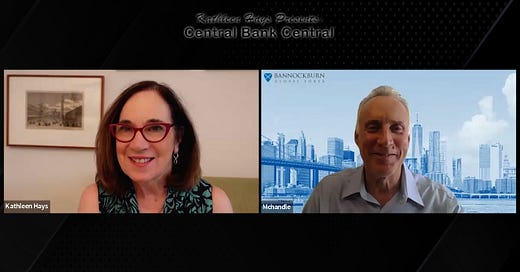Marc Chandler has been covering the foreign exchange markets for more than 30 years, going back to the 1985 Plaza Accord to weaken the dollar. ”I really like it,” he says. “It’s the biggest, most liquid of the capital markets…In three weeks the foreign exchange market is big enough to buy the world’s GDP.”
“King Dollar” has had its ups and downs, but coming out of the pandemic, and after the most aggressive round of Fed rate hikes in 40 years, the strong dollar has been a fixture of the global economy and financial markets.
Marc says the dollar is about to lose its crown as the Federal Reserve eases out of its rate hiking, inflation fighting interest rate cycle, and starts cutting rates, maybe even aggressively.
”I think the dollar is going to fall as a consequence,” he says. “I suspect the dollar’s peak is really behind us. But you know it takes awhile to turn this big ship around.”
The dollar got pounded along with stocks, bonds and gold after a weaker-than-expected July U.S. jobs report fueled investor bets not only that the Fed will raise its key rate at its September meeting but that it may start not with a 25bp cut but opt for at least two 50bp cuts by the end of the year.
More aggressive or not, Marc says Fed rate cuts will reverberate in central banks around the world.
Many major central banks and many in the emerging market space are on track to cut rates and more aggressively as the year winds down, he says, and Fed rate cuts will help them do this. “I think the Federal Reserve, their willingness to consider rate cuts, I think this also opens the door for more other countries to cut rates.”
So if the dollar has peaked and is starting to come down, what does Marc expect to see?
”The foreign exchange market, this huge market, and even though there’s rivals to the dollar, there’s some other important currencies, the dollar is still at the center stage, and so I think as the dollar weakens, that’s going to be the driver,” he says.
Marc says the U.S. Dollar Index peaked in 2022 at about 114, and after the U.S. jobs report at about 103.
”And I suspect in this cycle we’re going to go down to about 88 to 90,” he predicts. “So that’s not the end of the world. It says we should expect it’s roughly a 10, 15% pullback in the dollar over the next couple of years as the Federal Reserve eases.”
Marc also weighed in the Bank of Japan’s policy path and Fed rate cuts will affect it, and what is means for the yen to keep rising against the dollar. And how currency dynamics could affect the Bank of England’s policy path.
Wondering if the growing U.S. budget deficit will ultimately hit U.S bond sales and feed over to the currency market? How about the impact of a weaker U.S. dollar on U.S. businesses and consumers, and on nations that rely on exports to the U.S. to drive their economies?
We covered all of this and more. See what Marc has to say right here, right now.
Marc Chandler, chief market strategist at Bannockburn Global Capital Markets, which was acquired by First Financial Bank.
He has a popular blog at www.marctomarket.com, where his commentary is published nearly every day. His major point of view emanates from the foreign exchange market, the broadest and deepest of the capital markets, which the BIS estimates has an average daily turnover of $7.5 trillion a day. To put that in perspective, annual global trade is covered in less than a week, and the world’s annual GDP could be bought in less than three-weeks of fx turnover. He has written two books: Making Sense of the Dollar and Political Economy of Tomorrow. He is working on a third book, with a tentative title of “The End of Economic Primacy.”













Share this post